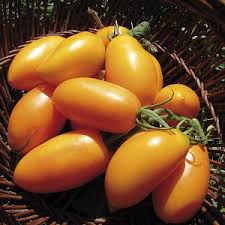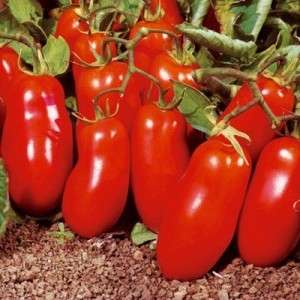Assorted colors in the beds: yellow and red tomato varieties “Rocket” and a practical guide to growing it
Due to its high yield and unusual shape, the Rocket tomato is of interest to summer residents. Many people love this variety of tomatoes, and for good reason! The fruits have a special taste and aroma, and also perfectly complement any holiday table.
In order not to waste time looking for this product in supermarkets and not to make a mistake with its naturalness, you can grow these tomatoes right at home or on your site. In this article we offer you step-by-step instructions on how to properly prepare seeds for planting, how to care for sprouts and harvest your own tomato harvest.
Tomato Rocket - characteristics and description of the variety
A distinctive feature of this tomato variety is its compactness. Rocket usually does not grow more than 60 centimeters, which makes it possible to grow these tomatoes at home.
Tomatoes ripen 120 days after the sprouts appear; the variety is considered mid-season. The medium-sized fruits with a pleasant taste have a specific shape: elongated, with a pointed nose, hence the name - Rocket tomatoes.
The yield does not disappoint: with a fairly dense seeding (about 10 bushes per 1 m²), you can collect 6-8 kg of fruit from every meter. This is why the variety is so popular among farmers: you can plant close to each other and harvest a large harvest.
 When the fruit acquires a bright red or yellow (depending on the planted variety) hue, we can talk about its maturity (see.photo). The yellow Rocket tomato is no different except for its color: it is just as easy to grow as the red Rocket.
When the fruit acquires a bright red or yellow (depending on the planted variety) hue, we can talk about its maturity (see.photo). The yellow Rocket tomato is no different except for its color: it is just as easy to grow as the red Rocket.
The fruits of the variety are quite dense and fleshy, do not spread or break when cut. They tolerate temperature changes and transportation well, can last a long time without spoiling (relative to other varieties), and are also resistant to diseases.
We grow seedlings
To grow seedlings of this variety of tomatoes at home, you need to prepare the seeds. Remember that the best time to germinate seeds is the second half of March.
They must first be soaked in hot water for about half an hour to be disinfected. The next step is germination. Place the seeds on a hard surface and cover with damp gauze.
Advice. Do not cover the seeds with thick cloth, this will prevent oxygen from reaching them.
It is necessary to ensure that the gauze remains moist, because moisture is what will ensure germination. After two days, you can start planting the seeds, but always in moist soil. It is necessary to plant in rows, retreating 1.5 cm from each seedling, maintaining a depth of about 2 cm. It is advisable to place 2-3 seeds in one hole so that they are sure to germinate.
For better conditions, close to greenhouse conditions, you can cover the box with seeds with cellophane. With regular watering, problems with seed germination should not arise if all of the above instructions have been followed.
Next, be sure to place the container closer to the light: on the window, and also observe the temperature norm for favorable cultivation: about +20 degrees. After a week, the temperature can be increased and brought closer to normal room temperature. Light should come from all directions so that the seedlings do not pull in one direction.To do this, you can change the location of the drawers or add an additional method of lighting - fluorescent lamps.
As soon as the seedlings have leaves, they need to be transplanted into separate containers: you can use plastic cups. For further successful growth, it is advisable to periodically take the seedlings outside: this will help harden them and adapt them to further transplantation into the greenhouse.
Growing tomatoes in a greenhouse
At the end of May (the optimal time for transplanting), the tomatoes are planted in the greenhouse, but at a distance of about 15-20 cm from each other. You can alternate bushes of yellow and red varieties: when the fruits appear, the garden bed will become very elegant and bright.
Important! Dense planting does not affect the yield of this variety in any way. Therefore, Rocket is perfect even for those summer residents who have a small plot of land.
First you need to dig up the ground, form beds, and sprinkle with fertilizers a couple of days before planting (you can use mineral or organic: humus, compost or regular chopped grass). Also in the future you can fertilize the bushes once a month.
Next, we monitor the growth of the bushes, tying them up if necessary (however, as a rule, this variety of tomatoes does not need tying up). If you are making a vertical garter in a greenhouse, it is worth making a support for the bush (it can be a peg or stick) and tying a branch and/or stem that is lowered under the weight to it with a piece of rope - this will make it easier for the plant to grow and develop.
With a horizontal tie, a highly tensioned wire or rope is used from one end of the greenhouse to the other. Ropes will be attached to it to support the branches and stems of plants.
Watering the tomatoes in the greenhouse you need water at room temperature 2-3 times a week. Try not to get it on plant leaves, as this can cause fungal disease. However, if you forget to water your plants on time, no need to worry: Rocket tomatoes are quite drought-resistant.
After watering, it is advisable to loosen the soil - this will allow the plant roots to breathe better. You can loosen it with a special hoe or garden fork, cultivating the soil 5 cm deep. This way you can prevent diseases of the plant roots and speed up its growth.
Important! Do not confuse loosening and weeding. You need to loosen the soil after watering, and weed the beds only as weeds sprout on it.
It is necessary to remember about timely pinching: cutting off young shoots from plant stems. After removing the stepsons, the bush should look like a stem with several branches that will bear fruit in the future. This will allow the plant to develop in its normal mode and bear fruit on time.
When it comes to growing tomatoes, you need to be aware of pests and plant diseases. Despite the resistance of this variety to diseases, fungal diseases are common. late blight. This is indicated by spots appearing on the leaves. This may be due to frequent watering, so at the first sign it is necessary to reduce the amount of moisture supplied to the plant.
Another common disease of the variety is mosaic. Its carrier is aphids. If you see white or yellow spots on the leaves, this is a mosaic. The affected leaves fall off, but you shouldn’t let this happen: tear off the diseased leaves in advance.
There is also a plant disease that manifests itself as brown spots.It can be cured by spraying with fungicides.
However, there are also pests that eat plants, for example, the cockchafer. Its larvae bite the roots of the plant and it dies. You can fight them by direct collection of larvae or with special preparations. from pests.
Subject to the regime of watering, loosening and feeding, as well as with proper monitoring and prevention of diseases and pests, you are guaranteed to get a good harvest of Rocket tomatoes.
The nuances of growing in open ground
It is not recommended to grow these tomatoes in open ground, as there are a number of nuances that hinder the healthy growth and development of the plant:
- Temperature regime. If the summer is quite cold, the sprouts may simply freeze and not bear fruit.
- Rains. If there is too much rain, the plant may develop fungal diseases or die from excessive moisture.
- Plants planted in open ground become more vulnerable to attacks by pests and diseases. For example, late blight begins due to rain.
Harvesting and application
Once the tomatoes turn bright red or yellow (depending on the variety), they can be harvested. As a rule, ripening occurs in July. You need to pick tomatoes carefully so as not to damage either the branches or the tomato itself. For storage You can put the fruits in a box lined with newspaper. There is no need to put too many tomatoes in one box, as the fruits lying below may become wrinkled.
The box should be stored in a dry place, but not in direct sunlight. The room temperature should not exceed +6 degrees, otherwise the tomatoes may begin to deteriorate.
If there is a need for long-term storage of tomatoes (more than 3 weeks), they should be removed from the branches slightly unripe and placed in boxes to ripen in the same way.

The use of the crop can be very diverse: the fruits of the described variety are very convenient to preserve, they fit perfectly into jars.
Rocket tomatoes will decorate your holiday table even in the form of regular cuts (especially if you alternate yellow and red fruits).
We also shouldn’t forget about the beneficial properties of tomatoes: tomatoes are a powerful antioxidant. Lycopene, which is part of the tomato, helps in the treatment of many diseases.
In addition, tomatoes have an antibacterial effect. Tomatoes can also fight blood clots, and due to the serotonin they contain, they improve your mood.
Advantages and disadvantages of the variety
So, the main advantages of this variety of tomatoes are:
- Compactness of the bush.
- Resistant to diseases and pests, as well as drought.
- Growth and development without tying up.
- Productivity: tasty, dense, bright fruits, pleasant aroma.
- Easy to care for and harvest.
Disadvantages include:
- To grow a healthy plant you need enough light and heat;
- the need for fertilizers and fertilizing;
- not the earliest terms of ripening.
What farmers say
Reviews about this variety on the Internet are positive. There are often comments about the ease of growing Rocket tomatoes and the large harvest. There are many reviews with recipes. Here are some examples:
Vasily, 54 years old, Moscow:
“Rocket is a wonderful variety that is easy to grow even for beginning gardeners. I didn’t plant the bushes, I just watered them periodically. Tomatoes tolerated drought well.”
Elizaveta, 48 years old, Khabarovsk:
“I chose the Rocket tomato based on photos, yield and reviews online. The variety is distinguished by smooth, small fruits. At the same time, they are quite dense and retain their shape well after heat treatment.”
Valentina, 36 years old, Izhevsk:
“I have been growing tomatoes on my plot for more than 10 years. Every year in mid-March I plant the Rocket variety. In May, I transfer some of the seedlings to the greenhouse, and plant the rest outside. I like Rocket tomatoes because they don’t need to be tied up or pinched. They do not exceed 40 cm in height.”
Conclusion
To summarize, we can say that the Rocket tomato is a variety that has been proven over the years. It is extremely tasty and easy to grow. It is advisable to plant plants in a greenhouse and promptly treat them against pests and infections.
By following the instructions in our article, even a novice gardener can get a rich harvest of tomatoes.